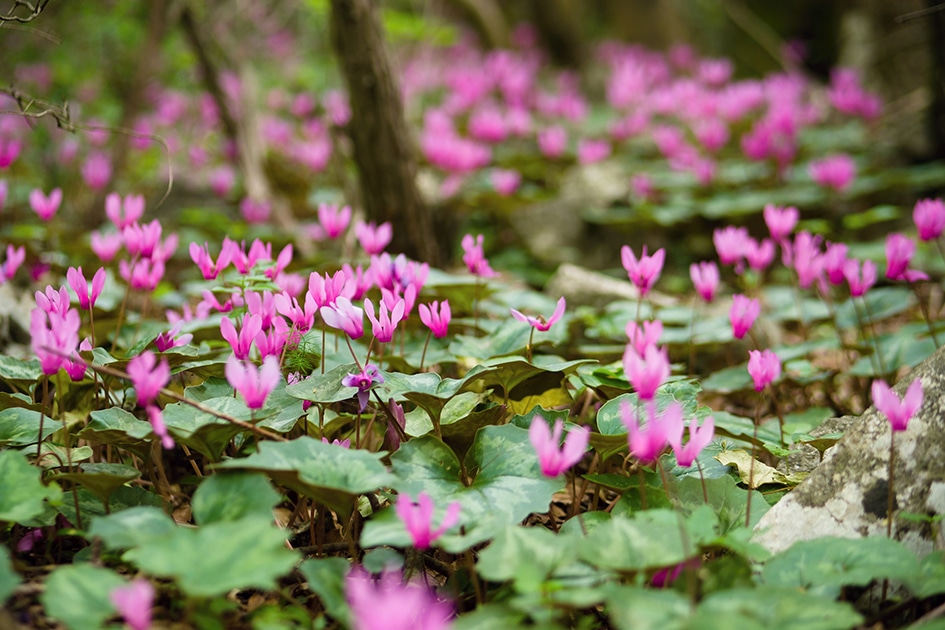One of the first signs of early wintertime is the swathes of C. hederifolium beneath trees in older gardens – each one a perfect pink miniature version of a shop-bought cyclamen.
Their leaves tend to emerge later and cover the ground all winter with a carpet of silver-splashed dark green tones. Like snowdrops, every plant has differently marked leaves and so this creates a stunning sight to behold. Plant them en masse in a woodland setting with ferns and other shade-tolerant plants or if your garden is small then around the base of deciduous trees will still create a striking effect.
- repandum takes over in March to finish the cyclamen season
There is also white form, known as C. album, which is particularly splendid if allowed to spread to form drifts. A pure white strain of this tough woodland cyclamen, it’s very hardy and l ooks amazing around about now as a mass underplant. In the garden these flowers will flourish beneath trees and shrubs, even conifers if the shade is not too deep.
In shadier areas where grass grows weakly they can be planted into the lawn and allowed to seed and spread (known as naturalising), but stop mowing from August to May while the cyclamen are in leaf.
If your garden is small then planting them around the base of deciduous trees will still create a striking effect
The flowers of the later blooming C. coum (each one no more than 1.5cm on 6cm-long stems) vary from deep, dark magenta through every shade of pink to pure white. In January and February their brightness livens up the garden– flowers and leaves will wilt during frosts, but they soon perk up as soon as the temperature rises above freezing. The colours of the cyclamen work very well against a backdrop of snowdrops.
By March another species, C. repandum, takes over to finish the cyclamen season. These also self-seed and spread. The flowers, in various shades of pink, appear in April and May and look especially nice planted among wild primroses. The petals are slender and elegantly twisted and some forms are sweetly scented. The plants need plenty of cool shade, and therefore a sheltered wooded area or similar will give the best results.
Scillas can be combined with cyclamen and other spring flowers
All hardy cyclamen grow best in well-drained, humus-rich soil. What they dislike most (apart from soggy, wet soil) is disturbance and competition so don’t plant in and amongst perennials in a herbaceous border. The places they thrive tend to be unattractive for many larger and later-flowering plants. They can be planted beneath shrubs, especially if these have their lower branches removed; and can be combined with other late-winter and spring flowering plants such as snow-drops, scillas, pulmonarias and narcissi.
In containers they are best grown in their own pot, sunk into the compost. When they have finished flowering, lift out the cyclamen from the pot and plant it in a shady spot for summer.
Top tips for November
1 Insulate your outdoor containers from frosts, using hessian or bubble wrap held in place with garden twine.
2 Raise pots off the ground for the winter by using bricks or ‘pot feet’, to prevent waterlogging.
3 Encourage hungry birds into your garden by investing in bird baths and bird feeders. Our feathered friends will keep pest numbers down and bring joy on a bleak winter’s day.
4 Protect roses from windrock by pruning them by one-third to half their height. This will stop them swaying in strong wind and prevent roots coming loose in the soil.
5 Remove fallen leaves from around the base of any rose bushes which suffered from blackspot or rust during the summer, to reduce the chance of them becoming infected again next year.
6 Continue to lift dahlia tubers, begonias and gladiolus corms to store dry over the winter months. Remove the dead foliage before storing.
7 Cut back the yellowing foliage of herbaceous perennials, lift and divide overcrowded clumps to maintain their vigour.
8 Cut a few stems of holly with berries for making Christmas garlands.
9 Aerate your lawn now – there’s still time to do it before winter sets in. You can either use a lawn aerator or simply insert a garden fork at regular intervals and lean it back slightly to let air in.
10 Continue to clear fallen leaves off the lawn to keep it healthy.
11 Set your lawn mower to a higher cut-height for winter.








